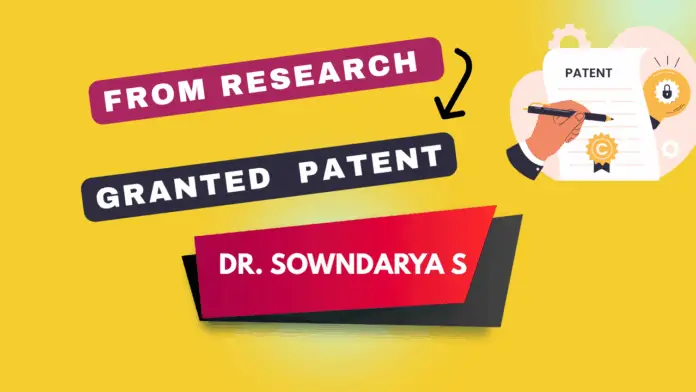After sharing my experience on how I got selected for an industry-funded project, I wanted to write this post as a continuation to show what happened next, and how a research idea grew into a patented innovation. Getting an Indian patent granted for my research work has been one of the most fulfilling milestones in my academic journey. It wasn’t just about getting recognition; it was about seeing how research can truly make a difference when it meets real-world needs.
How My Research Work Turned Into a Granted Indian Patent: A Journey from Laboratory to Real-World Impact
From Research to Innovation
My research focused on developing a novel and innovative reactor system for the treatment of wastewater generated in my University. With the support of an industry partner, we were able to go beyond theory. We worked together to design, develop, and test a system that was not only scientifically sound but also practically applicable.
The industry collaboration helped me understand the importance of solving real problems. When your research is aligned with what the industry needs, it pushes you to think differently—more practically, more innovatively.
Why We Decided to File a Patent
During the project, as we were refining our design and testing the system, I realized that we were creating something new; something that didn’t exist in the current market. Our reactor system combined sustainability, efficiency, and cost-effectiveness in a unique way.
That’s when the idea of filing a patent came in. I consulted with my supervisor, industry collaborators, and IPR team at our University. A patent not only protects your innovation but also gives your work a strong identity and recognition in both academic and industrial circles.
The Patent Process: A Learning Experience
Filing an Indian patent was a new experience for me. It involved:
- Documenting every step of our innovation in detail
- Preparing technical drawings and descriptions
- Writing the claims clearly and carefully
- Responding to the examiner’s queries and suggestions
Septs Involved in Patent Filing Process
Here’s a glimpse of how the patent filing process happened for me.
| Stage | Fee INR (University IPR charges) | Purpose & Details | Duration |
| Submission of Information disclosure form (IDF) to University’s IPR office for Prior Art Search | Search fee – Rs. 12,500/- | Novelty, Abstract, Background of the invention, and Detailed description of the invention with drawings | – |
| Submission of report in response to Prior Art search to IPR office | – | Detailed description and justification in comparison between our invention and existing (Advantages and drawbacks need to be highlighted) | 2 weeks |
| Conduct of patentability meeting | – | If the response meets the criteria such as novelty, non-obviousness and industrial applicability | 2 weeks |
| Drafting of complete specification and preparation of forms related to Patent application | Drafting fee – Rs. 12,500/- | Detailed technical description of the invention with suitable drawings, relevant and appropriate claims | 1 month |
| Filing of patent application | – | Patent application filed with in Indian patent office | – |
| Publication | Application published in Indian Patent Journal | Around 18 months | |
| Request for examination | Rs. 2000/- | Form 18 submitted for request for examination | Shortly after filing application (maximum 48 months from date of filing) |
| Examination & Response | Reply to FER – Rs. 7,500/- | Received First Examination Report (FER) and submitted the responses against the queries asked | 3 – 6 months |
| Grant of Patent | – | Received official grant notification from Indian patent | Around 2 – 3 years |
(Note: This timeline may vary depending on the type of application, number of claims, and speed of the examination)
The process took time and patience, but every stage taught me something new about clarity, precision, and how to communicate innovation effectively. In my next blog, I will share the frequently asked questions in patent filing.
Also Read: How to File an Indian Patent | Simple Procedure for Indian Patent Filing Online
Tips for Young Researchers: How to File a Patent in India
If you’re considering patenting your research, here are some practical tips based on my experience:
1. Identify the novelty
Ask yourself: Is your work new? Is it non-obvious? Is it useful? If yes, it may be patentable.
2. Keep detailed records
Document every experiment, observation, and development stage in a laboratory record. This helps in preparing the patent draft.
3. Avoid early publication
If you’re planning to patent your work, file the patent before publishing it in a journal or presenting it in a public forum.
4. Consult experts
Talk to your research supervisor, IPR cell (if your institution has one), or a registered patent agent.
5. Draft clearly
Claims are the heart of the patent. Be precise, and try to cover various possible claims.
6. Use online filing
The Indian Patent Office allows online filing at ipindia.gov.in. It’s faster and more convenient.
7. Follow up regularly
Track the status of your application, respond to FERs quickly, and stay updated with communication from the Patent Office.
8. Take support from your University
Universities/Institutions bear 70 – 80% of the charges involved in patenting your invention. Also, If your research has industry support or you have funds in your sponsored research project, it may be used for filing a patent.
Why I’m Sharing about my Granted Indian Patent
I want to tell young researchers and scholars:
My journey from research to patent taught me that innovation isn’t just about big inventions; it’s about solving real problems with a new approach. It begins with curiosity, grows with hard work, and becomes impactful when it reaches society.
Take Home Message
Don’t stop at completing your thesis or publishing papers. Take your research further. Think about its industrial applicability. Think about innovation. If your work solves a real problem, no matter how small, it has the potential to become something bigger. It could help communities, support industries, and even lead to start-ups or tech transfer. And if you think your idea is new and useful, file a patent. It’s a way to secure your work and open new doors.
To all young scholars out there—dream big, work smart, and take your research beyond the lab. The world needs more problem-solvers like you.
Happy researching!

